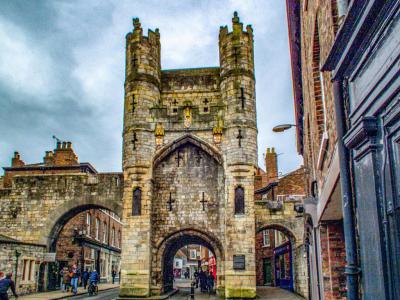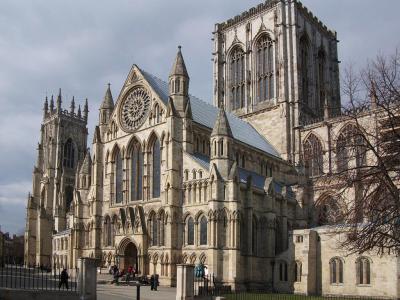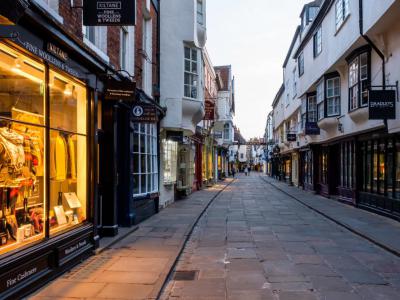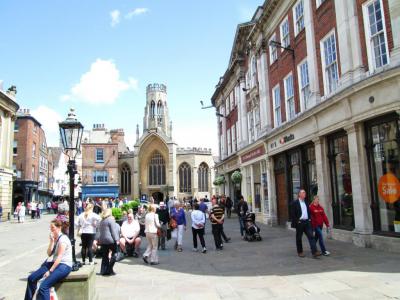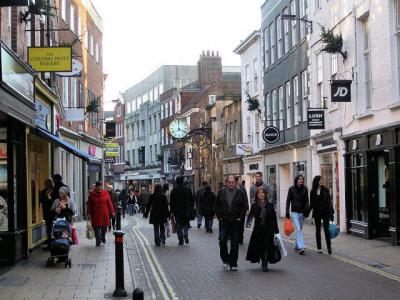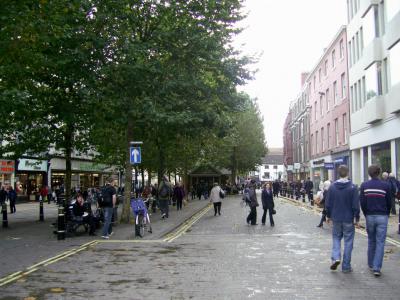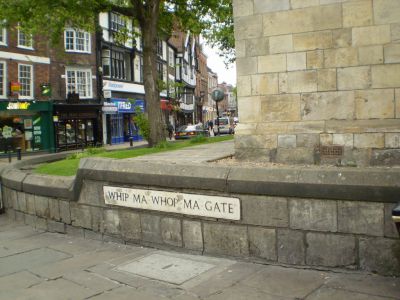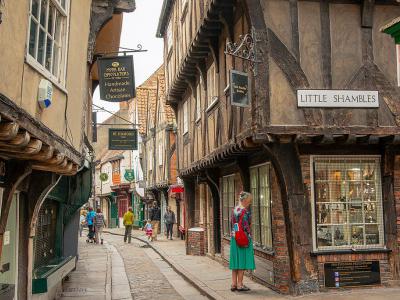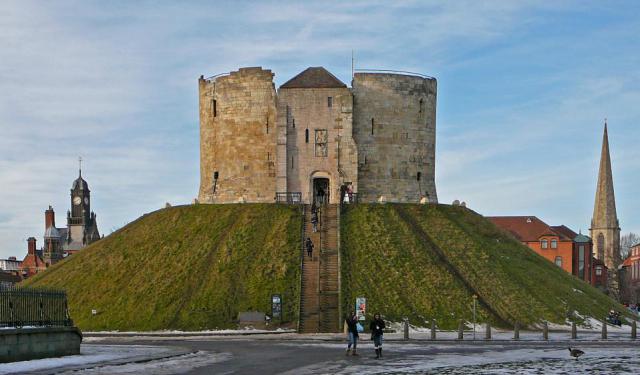
York's Old Town (Self Guided), York
A vibrant city with Roman roots and a Viking past, York has played a central role throughout much of England‘s history. Despite its small size, Old Town York boasts a wealth of colorful heritage that draws tourists in droves from all over the world.
The maze of historic streets – too narrow for vehicles, and therefore solely pedestrian – are packed with attractions fairly close to one another, which makes it a great place to explore on foot. With an array of quirky little details around and the ancient traditions hung in the air, it surely feels like walking back in time. Just make sure to wear some comfortable shoes!
To make a trip through the old capital of England’s north a little easier, here some of the essential stops to make along the way:
The Shambles – a medieval street, one of York’s oldest; formerly a meat market lined with butcher shops, hence the name. The buildings have a typical overhang of that period.
York Minster – the second-largest Gothic cathedral in Northern Europe and one of the tallest buildings in the city, as prescribed by the ancient local law.
Stonegate – among the most visited streets in downtown York, with most buildings listed as architecturally or historically important.
Parliament Street – a focal point and major shopping hub; mostly pedestrianized since the 1980s.
Whip-Ma-Whop-Ma-Gate – one of, if not the, smallest street in York; the name means "What a street!" or, the latest version, "Neither one thing nor the other".
If you're keen to have an unparalleled and pristine glimpse into the UK of a bygone era and to explore the attractions York’s Old Town so proudly displays, take this self-guided tour.
The maze of historic streets – too narrow for vehicles, and therefore solely pedestrian – are packed with attractions fairly close to one another, which makes it a great place to explore on foot. With an array of quirky little details around and the ancient traditions hung in the air, it surely feels like walking back in time. Just make sure to wear some comfortable shoes!
To make a trip through the old capital of England’s north a little easier, here some of the essential stops to make along the way:
The Shambles – a medieval street, one of York’s oldest; formerly a meat market lined with butcher shops, hence the name. The buildings have a typical overhang of that period.
York Minster – the second-largest Gothic cathedral in Northern Europe and one of the tallest buildings in the city, as prescribed by the ancient local law.
Stonegate – among the most visited streets in downtown York, with most buildings listed as architecturally or historically important.
Parliament Street – a focal point and major shopping hub; mostly pedestrianized since the 1980s.
Whip-Ma-Whop-Ma-Gate – one of, if not the, smallest street in York; the name means "What a street!" or, the latest version, "Neither one thing nor the other".
If you're keen to have an unparalleled and pristine glimpse into the UK of a bygone era and to explore the attractions York’s Old Town so proudly displays, take this self-guided tour.
How it works: Download the app "GPSmyCity: Walks in 1K+ Cities" from Apple App Store or Google Play Store to your mobile phone or tablet. The app turns your mobile device into a personal tour guide and its built-in GPS navigation functions guide you from one tour stop to next. The app works offline, so no data plan is needed when traveling abroad.
York's Old Town Map
Guide Name: York's Old Town
Guide Location: England » York (See other walking tours in York)
Guide Type: Self-guided Walking Tour (Sightseeing)
# of Attractions: 8
Tour Duration: 1 Hour(s)
Travel Distance: 1.3 Km or 0.8 Miles
Author: val
Sight(s) Featured in This Guide:
Guide Location: England » York (See other walking tours in York)
Guide Type: Self-guided Walking Tour (Sightseeing)
# of Attractions: 8
Tour Duration: 1 Hour(s)
Travel Distance: 1.3 Km or 0.8 Miles
Author: val
Sight(s) Featured in This Guide:
- Monk Bar
- York Minster
- Stonegate
- St. Helen's Church and Square
- Coney Street
- Parliament Street
- Whip-Ma-Whop-Ma-Gate
- The Shambles
1) Monk Bar
A bar is a gate in the medieval England - the word "bar" has its origin in barries. Monk Bar is ranked as the tallest and most elaborate of York's surviving medieval city gates. It was constructed in the early 14th century as a self-contained fortress, with each floor capable of being separately defended.
On the front of the bar is an arch supporting a gallery, including "murder-holes" through which missiles and boiling water could be rained down upon attackers. Later, it was used to jail unruly Catholics, and you can experience what it was like for being a "bad Catholic" by squeezing yourself into the cramped Little-Ease Prison tucked away in one of the towers.
Today, Monk Bar houses a fascinating museum dedicated to Richard III and has the only working portcullis in York, complete with spiked railings. Between Monk Bar and Bootham Bar is one of the nicest sections of York City Wall.
On the front of the bar is an arch supporting a gallery, including "murder-holes" through which missiles and boiling water could be rained down upon attackers. Later, it was used to jail unruly Catholics, and you can experience what it was like for being a "bad Catholic" by squeezing yourself into the cramped Little-Ease Prison tucked away in one of the towers.
Today, Monk Bar houses a fascinating museum dedicated to Richard III and has the only working portcullis in York, complete with spiked railings. Between Monk Bar and Bootham Bar is one of the nicest sections of York City Wall.
2) York Minster (must see)
The York Minister is an impressive cathedral with a long and storied history. The Romans settled here and named the area Eboracum in 71 AD. King Edwin was baptized in a small wooden church here in 625. A stone church was built, and King Edwin was buried in the stone church in 633. In 1088, a new Minister was built. The Minister was expanded between 1154 and 1225. In 1328, the York Minister hosted a royal wedding between King Edward III and Philippa of Hainault.
Richard Scrope, Archbishop of York, was accused of treason by Henry IV and beheaded in 1405. His tomb lies in the Minister.
The Minister as it stands today was completed in 1471. It is the second-largest Gothic cathedral in Northern Europe. The name "minister" harkens to Anglo-Saxon missionary churches. The cathedral's official name is the Cathedral and Metropolitical Church of Saint Peter in York.
The Minister features majestic architecture, including a Gothic nave and a Perpendicular Gothic quire. The 1408 Great East Window is the largest expanse of stained glass in the world. Each lancet in the magnificent Five Sisters Window is 53 feet tall. A gorgeous rose window graces the south transept. The design of the west window is known as The Heart of Yorkshire.
The transepts feature wooden roofs. The nave was completed in 1350 and is England's widest Gothic nave. The central tower is 235 feet tall (72 meters). The choir is 102 feet tall (31 meters). The octagonal Chapter House was built in 1280 and features wonderful stone carvings.
Visitors can view the remains of the Roman fort in the cathedral's museum.
Why You Should Visit:
The York Minister is one of the most impressive churches in Northern Europe. It was one of the few Catholic churches not destroyed by Henry VIII, as he wanted to convert it to an Anglican church. The soaring nave, impressive towers, storied history, and Gothic architecture are the highlight of any York visit.
Tips:
Go for an evensong service, usually held in the evenings at 5:15 pm, and experience the acoustic wonders of the choir and organ.
The 35 church bells ring at 10:00 am on Sundays.
Richard Scrope, Archbishop of York, was accused of treason by Henry IV and beheaded in 1405. His tomb lies in the Minister.
The Minister as it stands today was completed in 1471. It is the second-largest Gothic cathedral in Northern Europe. The name "minister" harkens to Anglo-Saxon missionary churches. The cathedral's official name is the Cathedral and Metropolitical Church of Saint Peter in York.
The Minister features majestic architecture, including a Gothic nave and a Perpendicular Gothic quire. The 1408 Great East Window is the largest expanse of stained glass in the world. Each lancet in the magnificent Five Sisters Window is 53 feet tall. A gorgeous rose window graces the south transept. The design of the west window is known as The Heart of Yorkshire.
The transepts feature wooden roofs. The nave was completed in 1350 and is England's widest Gothic nave. The central tower is 235 feet tall (72 meters). The choir is 102 feet tall (31 meters). The octagonal Chapter House was built in 1280 and features wonderful stone carvings.
Visitors can view the remains of the Roman fort in the cathedral's museum.
Why You Should Visit:
The York Minister is one of the most impressive churches in Northern Europe. It was one of the few Catholic churches not destroyed by Henry VIII, as he wanted to convert it to an Anglican church. The soaring nave, impressive towers, storied history, and Gothic architecture are the highlight of any York visit.
Tips:
Go for an evensong service, usually held in the evenings at 5:15 pm, and experience the acoustic wonders of the choir and organ.
The 35 church bells ring at 10:00 am on Sundays.
3) Stonegate
Stonegate is a street in the city center of York, in England, one of the streets most visited by tourists. Most of the buildings along the street are listed, meaning they are of national importance due to their architecture or history.
The street roughly follows the line of an old Roman road, which ran between what are now St Helen's Square and York Minster.
The street appears to have lost importance in the Anglian and Jorvik period. When York Minster was rebuilt in the 11th century, and stone for it was brought up the road, from a quay behind what is now York Guildhall. This appears to have brought the street back to prominence. Many of the buildings sit on the land belonged to the York Minster and the whole area soon becoming built up, mostly with tenements.
The street was known as "Stonegate" by 1119, probably named for stone paving, which would have been unique in the city at the time, although an alternative theory links the name to the stone hauled up to the Minster. Glass painters and goldsmiths became prominent along the road, while from the 1500s, it became known for printers and bookshops.
Because of the location of the street, it has historically been used for civic processions, from the York Guildhall to York Minster. It was also the site where three of the historic York Mystery Plays were performed. In 1570, Guy Fawkes, also known as Guido Fawkes for his involvement in the failed Gunpowder Plot of 1605, was born at a house on the street.
The British art historian Sr. Nikolaus Pevsner described the street as "perhaps the most attractive [street in the city], and one of the busiest. Narrow, quite long, and with a variety of good things". Due to its popularity with tourists, the street is pedestrianized. It was repaved in York stone in 2020.
The street roughly follows the line of an old Roman road, which ran between what are now St Helen's Square and York Minster.
The street appears to have lost importance in the Anglian and Jorvik period. When York Minster was rebuilt in the 11th century, and stone for it was brought up the road, from a quay behind what is now York Guildhall. This appears to have brought the street back to prominence. Many of the buildings sit on the land belonged to the York Minster and the whole area soon becoming built up, mostly with tenements.
The street was known as "Stonegate" by 1119, probably named for stone paving, which would have been unique in the city at the time, although an alternative theory links the name to the stone hauled up to the Minster. Glass painters and goldsmiths became prominent along the road, while from the 1500s, it became known for printers and bookshops.
Because of the location of the street, it has historically been used for civic processions, from the York Guildhall to York Minster. It was also the site where three of the historic York Mystery Plays were performed. In 1570, Guy Fawkes, also known as Guido Fawkes for his involvement in the failed Gunpowder Plot of 1605, was born at a house on the street.
The British art historian Sr. Nikolaus Pevsner described the street as "perhaps the most attractive [street in the city], and one of the busiest. Narrow, quite long, and with a variety of good things". Due to its popularity with tourists, the street is pedestrianized. It was repaved in York stone in 2020.
Sight description based on Wikipedia.
4) St. Helen's Church and Square
St Helen's Square is an open space in the city centre of York. During the Roman era, Eboracum's south-western gate, the porta praetorian, lay where the square is now located. The square is an important junction, with Coney Street leading from its southern corner, Lendal from the west, both Blake Street and Stonegate from the north, and Davygate from the east.
The south-western side of the square is occupied by the Mansion House, and there is also access to the York Guildhall, which can be seen through a gateway. On the north-western side, both the former Yorkshire Insurance Company and York County Savings Bank buildings were constructed in the mid-19th century and are now listed historical buildings, with the remainder of this side occupied by St Helen's Church.
St. Helen's Church stands out with its unique octagonal tower. The earliest evidence of St. Helen's Church is from the late 12th century, though it is possible to say that its foundation was laid earlier. It was rebuilt twice, in the 1550s and the 1850s. The tower was erected in 1814 and the chancel in 1858. It has a gorgeous interior with 14th and 15th century stained glass.
The south-western side of the square is occupied by the Mansion House, and there is also access to the York Guildhall, which can be seen through a gateway. On the north-western side, both the former Yorkshire Insurance Company and York County Savings Bank buildings were constructed in the mid-19th century and are now listed historical buildings, with the remainder of this side occupied by St Helen's Church.
St. Helen's Church stands out with its unique octagonal tower. The earliest evidence of St. Helen's Church is from the late 12th century, though it is possible to say that its foundation was laid earlier. It was rebuilt twice, in the 1550s and the 1850s. The tower was erected in 1814 and the chancel in 1858. It has a gorgeous interior with 14th and 15th century stained glass.
Sight description based on Wikipedia.
5) Coney Street
Coney Street is a major shopping street in the city centre of York, in England. The street runs north-west from the junction of Spurriergate and Market Street, to St Helen's Square. The street was first established in the Roman Eboracum period, running parallel to and outside the city's south-western wall. At the time, the city's bridge over the River Ouse lay at its northern end. Excavations have located remains of a 1st-century grain warehouse on the south-west side of the street.
The street was first recorded in about 1150, as "Cuningstrete", the King's Street. The use of "street" rather than "gate" suggests that the name dates from the Anglian period, and two coin hoards from the period were found in the 1760s.
In 1308, Coney Street was described as the most important street in York. In 1335, a row of houses were built in the churchyard of St Martin; almost entirely rebuilt on several occasions, the last remains survived until 1958. In 1396, the Gild of St Christopher Maison Dieu almshouse was constructed on the street, and in 1459, York Guildhall was built next to it, at the northern end of the street. York Mansion House was built in front of it in 1725, and in 1782 the area in front of it was cleared to create St Helen's Square.
During the 19th-century, the street became lined with shops, noted businesses including the House of Bewlay tobacconist, Burgin's perfumery, and the Leak & Thorp department store. During the 20th-century, an increasing number of the shops were taken over by national chains. Despite the closure of several shops in the 2010s, the street remains home to a mix of High Street shops and cafes, while numerous buskers perform throughout the day.
The street was first recorded in about 1150, as "Cuningstrete", the King's Street. The use of "street" rather than "gate" suggests that the name dates from the Anglian period, and two coin hoards from the period were found in the 1760s.
In 1308, Coney Street was described as the most important street in York. In 1335, a row of houses were built in the churchyard of St Martin; almost entirely rebuilt on several occasions, the last remains survived until 1958. In 1396, the Gild of St Christopher Maison Dieu almshouse was constructed on the street, and in 1459, York Guildhall was built next to it, at the northern end of the street. York Mansion House was built in front of it in 1725, and in 1782 the area in front of it was cleared to create St Helen's Square.
During the 19th-century, the street became lined with shops, noted businesses including the House of Bewlay tobacconist, Burgin's perfumery, and the Leak & Thorp department store. During the 20th-century, an increasing number of the shops were taken over by national chains. Despite the closure of several shops in the 2010s, the street remains home to a mix of High Street shops and cafes, while numerous buskers perform throughout the day.
Sight description based on Wikipedia.
6) Parliament Street
Parliament Street is a major shopping street in the city centre of York. It was the site of the city's main street market from 1836 to 1955, and was largely pedestrianised in the 1980s.
Until the 19th-century, what is now Parliament Street was covered with buildings, facing onto Pavement, Jubbergate, and St Sampson's Square. The markets in Pavement and St Sampson's Square had become increasingly crowded, and after considering the possibilities of enlarging them, or establishing a new market on various potential sites, the city corporation decided to construct a broad street linking the two, which would become a new marketplace.
The Parliament Street Market opened in 1836, running every day, but with Saturday as the principal market day. It was the city's main market until 1955, when it completed a move to what is now the Shambles Market. In 1989, a competition was held to redesign the street, and this led to it being largely pedestrianised, with a single carriageway on one side. A variety of High Street shops now line the street, including a large branch of Marks and Spencers, and it is also used to host a variety of festivals and temporary markets.
Until the 19th-century, what is now Parliament Street was covered with buildings, facing onto Pavement, Jubbergate, and St Sampson's Square. The markets in Pavement and St Sampson's Square had become increasingly crowded, and after considering the possibilities of enlarging them, or establishing a new market on various potential sites, the city corporation decided to construct a broad street linking the two, which would become a new marketplace.
The Parliament Street Market opened in 1836, running every day, but with Saturday as the principal market day. It was the city's main market until 1955, when it completed a move to what is now the Shambles Market. In 1989, a competition was held to redesign the street, and this led to it being largely pedestrianised, with a single carriageway on one side. A variety of High Street shops now line the street, including a large branch of Marks and Spencers, and it is also used to host a variety of festivals and temporary markets.
Sight description based on Wikipedia.
7) Whip-Ma-Whop-Ma-Gate
Whip-Ma-Whop-Ma-Gate is one of the smallest streets in York, if not the smallest. It is between Colliergate and Fossgate and intersects The Pavement and The Stonebow in York city centre. It is currently a length of raised pavement between St Crux church hall and a road junction.
The origin of the name is unclear. A plaque erected in the street states that it derives from a phrase Whitnourwhatnourgate meaning "What a street!", but most modern sources translate the phrase as "Neither one thing nor the other". The city's whipping post and stocks were here in the middle ages, which may have influenced the change to the modern spelling and has certainly provided an alternative folk etymology.
The origin of the name is unclear. A plaque erected in the street states that it derives from a phrase Whitnourwhatnourgate meaning "What a street!", but most modern sources translate the phrase as "Neither one thing nor the other". The city's whipping post and stocks were here in the middle ages, which may have influenced the change to the modern spelling and has certainly provided an alternative folk etymology.
Sight description based on Wikipedia.
8) The Shambles (must see)
The Shambles is a historic street. Shambles refers to a meat market, and several streets with butcher shops are named The Shambles. Butcher stalls in this area were named in the 1086 Doomsday Book. The oldest buildings that line The Shambles today were built in the 14th century, and most were built by 1475. By 1426 the street was known as the Great Flesh Shambles, and later the street name was shortened to The Shambles.
Slaughterhouses were set up at the back of the butcher shops. The pavements were raised on the cobblestone street to allow easier cleaning of blood.
This narrow street features overhanging buildings, and some areas are so skinny that visitors can touch both sides of the street at once. The overhanging buildings would have sheltered the walls below and protected the display meat from the sun.
Visitors will find a shrine to Saint Margaret Clitherow on this street. Known as the "Pearl of York," she was martyred in 1586 for refusing to enter a plea to the charge of harboring Catholic priests. Saint Margaret Clitherow was married to a butcher and lived on The Shambles.
Butchers no longer line The Shambles, but several buildings still display meat hooks and meat shelves on display. Today's shops include restaurants, a bakery, and a bookshop.
Shambles Market runs daily between The Shambles and Parliament Street.
Why You Should Visit:
The Shambles is known as one of the best-preserved medieval streets in England. While fans believe it may have been the inspiration for Harry Potter's Diagon Alley, author J.K Rowling has denied these rumors. Regardless, the charming narrow street will transport visitors back in time.
Tips:
Visitors will also love exploring the five snickelways that lead off The Shambles. These snickelways are narrow alleys that connect to other streets.
Slaughterhouses were set up at the back of the butcher shops. The pavements were raised on the cobblestone street to allow easier cleaning of blood.
This narrow street features overhanging buildings, and some areas are so skinny that visitors can touch both sides of the street at once. The overhanging buildings would have sheltered the walls below and protected the display meat from the sun.
Visitors will find a shrine to Saint Margaret Clitherow on this street. Known as the "Pearl of York," she was martyred in 1586 for refusing to enter a plea to the charge of harboring Catholic priests. Saint Margaret Clitherow was married to a butcher and lived on The Shambles.
Butchers no longer line The Shambles, but several buildings still display meat hooks and meat shelves on display. Today's shops include restaurants, a bakery, and a bookshop.
Shambles Market runs daily between The Shambles and Parliament Street.
Why You Should Visit:
The Shambles is known as one of the best-preserved medieval streets in England. While fans believe it may have been the inspiration for Harry Potter's Diagon Alley, author J.K Rowling has denied these rumors. Regardless, the charming narrow street will transport visitors back in time.
Tips:
Visitors will also love exploring the five snickelways that lead off The Shambles. These snickelways are narrow alleys that connect to other streets.
Walking Tours in York, England
Create Your Own Walk in York
Creating your own self-guided walk in York is easy and fun. Choose the city attractions that you want to see and a walk route map will be created just for you. You can even set your hotel as the start point of the walk.
York's Historical Pubs Tour
Yorkshire is a haven for real ale enthusiasts and York does live up to this reputation. Many of local pubs are as old as churches, having served their clients for centuries.
There's a plethora of historic pubs in the heart of York, offering an array of quality cask ales alongside a menu of hearty British food, served in a cozy, traditional atmosphere. Low ceilings, wonky floors and open... view more
Tour Duration: 1 Hour(s)
Travel Distance: 1.3 Km or 0.8 Miles
There's a plethora of historic pubs in the heart of York, offering an array of quality cask ales alongside a menu of hearty British food, served in a cozy, traditional atmosphere. Low ceilings, wonky floors and open... view more
Tour Duration: 1 Hour(s)
Travel Distance: 1.3 Km or 0.8 Miles
York's Historical Architecture
Being home to some of the best preserved historic architecture in England, York screams history and is undoubtedly the must-go destination for anyone keen on the country’s past. While the more recent history has also characterized York, it is the abundance of the ancient sites retained in their variety – from Medieval times to the Georgian and Victorian eras, and more – that makes the city... view more
Tour Duration: 2 Hour(s)
Travel Distance: 3.1 Km or 1.9 Miles
Tour Duration: 2 Hour(s)
Travel Distance: 3.1 Km or 1.9 Miles
York City Wall Tour
Known variously as the York City Walls, Bar Walls, or the Roman Walls (although very little of the extant stonework has remained since Roman times) are the historic monument encircling the Old Town of York.
The surviving portion of the town wall – 3.4km (2 miles) – is longer than anywhere else in England. Built mostly in the 13th century (of magnesian limestone, and set upon earthen... view more
Tour Duration: 2 Hour(s)
Travel Distance: 3.8 Km or 2.4 Miles
The surviving portion of the town wall – 3.4km (2 miles) – is longer than anywhere else in England. Built mostly in the 13th century (of magnesian limestone, and set upon earthen... view more
Tour Duration: 2 Hour(s)
Travel Distance: 3.8 Km or 2.4 Miles
York Introduction Walking Tour
Established by the ancient Romans in 71 AD, the city of York breathes history. It first appeared as a walled settlement when the Ninth Legion of Rome conquered the local tribe known as the Brigantes. The town became the capital of the Roman province of Britannia Inferior, and later of the kingdoms of Deira, Northumbria and Jórvík, emerging as a major river port and part of the extensive trading... view more
Tour Duration: 2 Hour(s)
Travel Distance: 2.6 Km or 1.6 Miles
Tour Duration: 2 Hour(s)
Travel Distance: 2.6 Km or 1.6 Miles
The Most Popular Cities
/ view all
